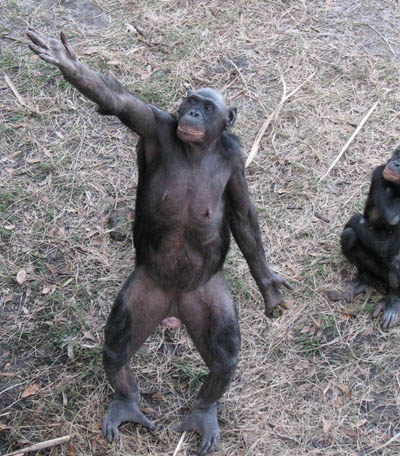The title of this article might mislead some readers. While Bonobos and chimpanzees share a 94% genetic similarity to us, we need to remember that they are merely the closest relatives on the evolutionary tree that survives today. If both these species were to go extinct, which appears increasingly likely, the title of this article would become, “Are we more like orang utans or gorillas?” As close a resemblance these many primates bare to us, there were other species in the past that that were even more human-like, like Neanderthals and Homo erectus. The later, despite the close relationship, would have probably killed and eaten you upon first introductions.
 Homo Erectus (the Velociraptor of Human Ancestry) |
We humans share a common ancestor with all chimpanzees that existed five to eight million years ago, bonobos and common chimpanzees diverged less than one-million years ago, soon after they became separated by the formation of the Congo river. Bonobos are technically a type of chimpanzee, but, for the purposes of this article, the world “chimpanzee” refers to the common chimpanzee, Pan troglodytes.
Both chimpanzees and bonobos use tools, from stones to crack nuts to sticks to fish termites out of mounds. The two species also have the capacity for language, with case studies of chimpanzees exhibiting a sign-language vocabulary of over one-hundred words, as well as bonobos making up new words. Both have expressive faces, which we humans can easily read and understand what’s being communicated, and both exhibit signs of empathy toward one another and to other species.
While both species use tools, chimpanzees use spears, which they sharpen with their teeth, to hunt other primates. Chimpanzees are the only other primate observed hunting in groups, sometimes going on border patrols where they actively seek out neighboring groups of chimpanzees and kill them. Chimpanzees also practice infanticide and cannibalism, both males and females killing and eating chimpanzee offspring that is not their’s. This is a symptom of the chimpanzee’s highly-patriarchal (male-dominated) society, where male domestic violence toward females is commonplace as a means of bullying them into submission.
 Bonobos Credit: collisionality |
Bonobos, have a much more peaceful society. They are mostly frugivorous, supplementing their diets with occasional invertebrates, like termites, or small mammals like flying squirrels. Physically, bonobos are “more elegant, longer-legged, and smaller-headed than chimpanzees.” Their body proportions resemble that of Australopithecus, a close ancestor to humans long extinct. This means that Bonobos also more closely resemble us physically, walking upright 25% of the time, exhibiting broader shoulders than chimpanzees and the females having more pronounced breasts.
In contrast to chimpanzees, bonobos have a matriarchal (female-dominated) society, where females are given the highest respect, and which is highly sexualized. While chimpanzees resolve conflicts through violence, bonobos resolve them through sex, both heterosexual and homosexual. When bonobos discover a wealth of food, they immediately diffuse any tension over who gets how much with an orgy. It’s no wonder bonobos are often called the “Make-love-not-war chimp.”
Because bonobos split off from chimpanzees millions of years after humans split off from our common ancestor with pans troglodyte, it would be inaccurate to say we got our behaviors from bonobos, and it would also be inaccurate to say we got our behaviors from chimps, as we have no idea what chimpanzee culture was like five million years ago, and culture, as we see in human history and the divergent histories of bonobos and chimpanzees, evolves very rapidly.
What we can ask from this exercise in comparing our evolutionary cousins is which cultural strategy works best? Both chimpanzees and bonobos are successful cultures, except in the face of human exploitation, and we can all refer to examples of domestic violence, murder, war, peace, free-love, and cooperation in human society. Each strategy works within certain social environments, so perhaps the real question is, which society would you rather live in?
Further Reading:
- Between the time of my writing this and its publication today, wild bonobos were observed hunting and eating the young of other primate species. Adjust your paradigms accordingly.
- Check out some amazing photos of bonobos here by Frans de Waal.
- The Bonobo conservation Initiative offers means for ordinary people to contribute to the preservation of this endearing species.
- An older, more thorough Scientific American article exploring the differences between bonobos and chimpanzees.
- A New Yorker article wonders if bonobos are really the peace-loving hippies we make them out to be?
 Bonobo Conservation Initiative |
Comments
2 responses to “Are Homo Sapiens More Like Bonobos or Common Chimpanzees?”